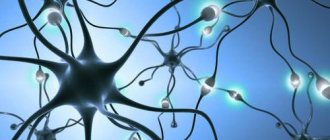Paramnesia or pseudoamnesia is presented as one of the types of disturbances in the memorization process and is characterized by the distortion of memories and the replacement of real events with fictitious ones.
There are other memory disorders that manifest themselves in disturbances in memorizing, storing, forgetting and reproducing information.
Depending on which memory function is impaired, in addition to paramnesia, the following types of memory disorders are distinguished:
- Dysmnesia or memory weakness is a pathology in which the patient loses the ability to effectively remember current factual information. It is most pronounced at moments when an answer must be given as quickly as possible.
- Amnesia is a complete or partial loss of memories due to a traumatic emotional or physiological factor. It can be either temporary – from several minutes to several weeks – or irreversible.
Paramnesia differs from all other pathologies in that with it the memory is not weakened or lost, but only distorted.
Qualitative disturbances are primarily associated with a distortion of self-awareness. The concept was introduced in 1886 by Emil Kraepelin. In another way, he called this disease “memory deception .
People with paramnesia experience confusion between past and current events, as well as real and imagined memories. This is mainly due to the fact that the patient attaches great importance to those events or roles that happened to him in the past. In psychology, the term refers to inaccurate or erroneous interpretations of the facts of one's autobiography.
History of research
Memory is a person’s ability to remember things that happened to him or to the environment. The brain itself constantly analyzes any information it receives, but at some point a failure may occur and the memorization process is disrupted.
The false memory effect has been studied for many years, but to this day it has not been possible to clearly explain why this happens. For the first time, a doctor from France, Florence Arnault, described his visual sensations associated with a flash of false memories and called them “déjà vu.” However, this effect occurs both from something heard and from a new smell, that is, it may seem to a person that he has previously heard some text or a certain aroma.
American psychologist Elizabeth Loftus also conducted research in this direction and came to the conclusion that the phenomenon of false memory can form trust in a certain person or organization. The most striking example is the influence of the media on the consciousness of the masses.
Features of the flow
Psychological
Short-term memory impairment (STM)
In psychology, short-term memory is a memory that has a small volume and is capable of retaining images for a short time - no more than 3 days. After this, the information is subject to processing and goes into the possession of long-term memory. Plays an important role in memorization. If it is violated, the events of the present are poorly recorded. The sufferer cannot learn a quatrain or remember his own daily routine. The main reasons are undeveloped intelligence, stressful situations, overwork, depression, intoxication of the body (alcohol, for example).
Vicarious memory disorders
To improve memory, experts often recommend training its indirect form. For example, to remember a certain event, some kind of “anchor” is reproduced - a smell, an image, a code word, a taste, etc. This technique can be used when learning a foreign language (associating the memorized words with Russian). In some mental pathologies, mediated memory is impaired, and the patient cannot reproduce the intermediate link that would help him remember everything else. Most often this is observed in schizophrenia and rigidity of emotional attitudes.
Impairment of the motivational component of memory
It is believed that unfinished actions are remembered better than completed ones. This is due to the motivational component of memory. If a person knows that he has finished something, he no longer sees the point of returning to it. If the task remains unsolved, it will constantly pop up in your thoughts and require further development. If this component is violated, the patient never brings the tasks assigned to him to their logical conclusion, because he simply forgets about them. This leads to social maladjustment, as others begin to consider him irresponsible and frivolous.
Pseudoamnesia
Some experts classify pseudoamnesia as a memory disorder, while others consider it a mental disorder of mnestic activity. The cause is extensive damage to the frontal lobes of the brain. Involuntary memory works, while voluntary memory turns out to be dysfunctional.
Example. A person suffering from pseudoamnesia is given the task of memorizing as many words as possible by ear. Out of a dozen spoken words, he will be able to reproduce no more than 3. However, if you give him pictures that depict what was just spoken, he will recognize a much larger number than he previously reproduced.
Age
In children
Mnemonic disorders in a child can most often be caused by two factors: serious somatic illnesses (after trauma, mental retardation or schizophrenia) or disorders of thinking and attention. Sometimes the cause is pedagogical neglect, if it was not developed in accordance with age. Usually, violations are detected in younger schoolchildren: compared to their classmates, such children cannot reproduce poems by heart, cannot retell them, are unable to concentrate in class, and have low intelligence.
The success of the correction directly depends on the reasons. For example, psychotraumatic factors are removed with the help of psychotherapists, somatic ones - through therapeutic treatment, pedagogical ones - with developmental programs.
In adolescence and middle age
Memory impairment during this period occurs, as a rule, as a result of acquired diseases and injuries. Moreover, with age they can become increasingly unstable. That is, during prolonged depression and excessive stress, they become aggravated (short-term memory suffers first of all), and after recovery everything returns to normal.
In old age
Over time, the nervous system and brain undergo natural aging processes. They gradually atrophy, the number of neurons decreases, and the connections between them weaken. This becomes the main cause of mnemonic disorders in old age. However, if you lead a healthy lifestyle and, if possible, avoid traumatic factors, this moment can be delayed.
Fact. The main violations occur after the age of 50 years.
Pathological
For a number of diseases, the most persistent and frequent disorders are diagnosed:
- in schizophrenia, such types of disorders develop as hypermnesia, anekphoria, pseudoreminiscences, fixation and progressive amnesia,
- for epilepsy and after a stroke - anteroretrograde,
- with TBI - retrograde and anterograde.
Experts also note other diseases associated with memory impairment.
Quantitative disorders may be associated with the following pathologies and conditions:
- oligophrenia, manic syndrome, drug addiction - hypermnesia,
- neurotic disorders, major drug addiction, psychoorganic, paralytic syndromes - hypomnesia,
- hypoxia - retrograde memory loss,
- Korsakovsky non-alcoholic psychosis, amentive syndrome - anterograde,
- stupor, stupor, coma, delirium, oneiric syndrome - congrade,
- coma, amentive syndrome, toxic brain damage, stroke - anterograde,
- Korsakovsky non-alcoholic psychosis, dementia, paralytic syndrome - fixation,
- chronic fatigue syndrome, psychoorganic syndrome, lacunar dementia - anekphoria,
- dementia, senile dementia, Pick's and Alzheimer's diseases - progressive,
- psychogenic disorders - affectogenic,
- hysterical, psychopathic syndrome - hysterical,
- alcoholism is a palimpsest.
Qualitative disorders are most often associated with diseases such as:
- Korsakov's non-alcoholic psychosis, dementia - pseudoreminiscences,
- Korsakovsky non-alcoholic psychosis - confabulosis,
- psychoorganic and paranoid syndromes - cryptomnesia,
- psychoorganic syndrome - echonesia,
- Depersonalization and derealization personality disorders are phenomena of what has already been seen and heard.
Memorization process
A person perceives the world around him with the help of smell, touch, hearing, sight, taste. All these feelings are interconnected. The memorization process can occur on the basis of emotional, verbal and logical analysis, figurative and motor facts.
False memory is formed according to the same principles, so it is divided into auditory, visual, and so on.
Rare attacks of pseudomemory that do not affect a person's life are not considered dangerous. However, if this happens on an ongoing basis, then it is further confirmation that unhealthy processes are occurring in the brain and/or psyche and, perhaps, the patient has already developed false memory syndrome. If this significantly affects an individual’s lifestyle, doctors call this condition paramnesia.
Classification
Confabulation as a symptom is observed in various psychopathologies . Accordingly, in each specific case there is a different etiology, different depth and severity of memory impairment, and different accompanying symptoms. As a result, the manifestations of such a disorder are also quite different.
For this reason, in psychology and psychiatry, confabulations are divided into two main groups, in which the patients’ fiction differs both in its content and in its original origin.
By content
Mnemonic . False memories affect everyday life or professional activities in the current time.
Ecmnestic confabulation most often accompanies progressive amnesia in middle-aged and elderly patients.
False memories are associated with the past: from youth to childhood. There is no idea of real age and present time.
Fantastic . Such memory deception is a typical symptom of paraphrenic syndrome - a combination of affect with delusions of grandeur, influence and persecution. False memories differ from all previous forms in their scale of unreality: from historical events of the distant past to the no less distant future. Often this type of confabulation runs parallel to paraphrenic delirium.
By origin
Suggested is the most common form. It is expressed by a laconic and expected answer to the question posed. No matter how absurd the tips are, the patient does not notice the catch.
Spontaneous - the patient tells impressive stories invented on the spot. He answers the question posed incorrectly, while embellishing his answer as much as possible in order to impress the listener.
Oneiric - caused by a violation of consciousness of the productive type. Fictional memories relate to the subject of psychosis experienced in schizophrenia, oneiric syndrome, hallucinations or epilepsy.
Occasionally occurs in organic, infectious or intoxication psychosis.
Expansive - fictitious facts are associated with delusions of grandeur and obsessions, when the patient considers himself a genius, extremely rich and even a titled person.
Replacement mnestic - confabulation is expressed by replacing memory gaps with events of both past years and the present.
Delusional - does not refer to clouding and memory impairment. Arises as a result of the patient's delusional ideas. Typical of the paranoid syndrome of schizophrenia.
Types of paramnesia
One of the manifestations of false memory is pseudoreminiscence. A person who has experienced a strong insult in the distant past constantly remembers it and after some time begins to perceive it as something that happened recently. This condition is typical for middle-aged people.
Contabulation or implausible stories is a state very similar to pseudo-reminiscence, but everything that happened in the past is diluted with fictitious stories. This condition is typical for alcoholics and drug addicts, for people who take psychotropic drugs or are diagnosed with schizophrenia.
Cryptomnesia or fantastic dreams is a condition characteristic of impressionable individuals. The plot of a book you read can become part of the life of a person who gains confidence that everything described happened to him.
Causes
Where does false memory come from, and why can't you trust memories? In fact, the exact cause of pseudomemory has not yet been identified. Most often, this problem is encountered by people with damage to the front part of the brain, the frontal lobes.
Provoking factors include:
- traumatic brain injuries;
- Korsakoff's syndrome;
- acute cerebrovascular accidents;
- malignant neoplasms in the brain;
- senile dementia;
- epilepsy;
- Alzheimer's, Parkinson's, Pick's and other ailments.
Severe intoxication with drugs, alcohol, and psychotropic substances quite often causes memory problems.
Symptoms and diagnosis
The main symptom, as already mentioned, is passing off facts from the past as the present. The patient fills in the existing gaps with events that happened before. Facts about what did not happen can also be added, but they are always of a secondary nature.
Diagnosis is aimed primarily at identifying the underlying disease. It may include the following examinations and tests:
- collecting anamnesis, asking about the time of onset of symptoms and concomitant disorders;
- a series of psychological tests to understand the perception of reality and evaluate memory;
- magnetic resonance imaging of the brain to assess its functional state;
- general blood test, biochemical and for toxins;
- electroencephalography;
- CT scan;
- Consultations with a neurologist, neurosurgeon and other doctors are necessary.
Differential diagnosis is carried out with delusions and true hallucinations, disorders that accompany manic-depressive syndrome, however, unlike paramnesia, they cannot be corrected.
Examples from life
If we don’t talk about extremes, then the so-called gray zones of memory are present in every person, and some non-existent facts are perceived as real throughout life. For example, Marilyn Monroe claimed in many interviews that she was raped at the age of 7. However, each time she called a different name of the rapist.
Marlene Dietrich had similar memories. She was sure that at the age of 16 she was raped by a music teacher, and she clearly always said the same name. However, after a thorough check, journalists found out that such a teacher really existed, but at the time when Marlene was 16 years old, he did not even live in Germany.
There are many more cases involving false memory. Some stories even ended in litigation. One thing is clear: if a person constantly convinces himself that this or that event has happened, then over time it will become a reality for him. And political strategists and marketers use this quite successfully.
Symptoms
General symptoms for most species:
- confusion,
- forgetfulness,
- inability to recall previously occurring events or learned information in memory,
- social maladjustment,
- confusion,
- autism, nervous system rigidity.
If the disorders are caused by some kind of somatic or mental illness, they are accompanied by symptoms characteristic of them.
Violations of various higher mental functions often overlap, which is also manifested by various deviations. For example, memory impairment and
- thinking: if a person does not have high mental abilities, it is difficult for him to remember information, this is especially clearly seen in cases of dementia and mental retardation, when obvious memory problems are diagnosed,
- attention: unstable, slow or insufficient concentration leads to the fact that information is not remembered.
It must be borne in mind that each individual disorder is characterized by a specific clinical picture.
Pseudo-memory on a global scale
What is the false collective memory effect called? The second name of the phenomenon is the “Mandela effect.” The story is really about Nelson Mandela. This happened in 2013, when information appeared that the President of South Africa had died. Search engines were overloaded with queries about this event. This is due to the fact that most of the world’s population was completely sure that this person died back in the 70s of the last century. Indeed, Mandela went to prison during these years, where he spent more than 25 years, but after his release he continued his activities to protect human rights and even became the president of the country.
Many researchers became interested in this fact, but they failed to find a rational explanation for this phenomenon.
Echonesia: we are a long echo of each other
It is no coincidence that the name of this disorder, in addition to the ancient Greek word mnesis - memory, also includes the word echo - reflection.
For the event of the past, like a lost and restless echo, is endlessly repeated in the head of the “sufferer” from a love “illness” or from another similar reason. There is even a case described when a date with the same person was “repeated” for the sufferer “in the same room” no less than 80 times!
At that time, the obsessive state was explained by intoxication psychosis (Dibenamine), very similar symptoms are observed with quinine intoxication.
Related to dual perception, the phenomenon of echonesia (or reduplicating Pick's paramnesia) can be a consequence of:
- Korsakov's syndrome;
- dementia;
- paralysis;
- psychosis;
- pathological process in the temporoparietal region.
Russian examples
The manifestation of mass false memory occurs quite often in history. In our country, it is customary to blame Catherine the Great for the fact that Alaska belongs to America. In fact, it has nothing to do with the sale of this part of the continent. Alaska was sold by Alexander II, who came to power almost 100 years later.
Another common myth is that the poem that begins with the words “I’m sitting behind bars in a damp dungeon...” was written by Lermontov. In fact, this creation belongs to Pushkin.
From recent history, the most striking example is associated with Yeltsin. Many are sure that before leaving he said the following phrase: “I’m tired, I’m leaving.” Although, in fact, he only said the second part of the sentence.
Almost everyone remembers the movie “Beware of the Car,” and the phrase that became a catchphrase: “Boy, get away from the car.” In fact, it was heard in a completely different film - “A Secret to the Whole World.”
People who studied in Soviet times remember that they were always taught in school that Hitler had brown eyes, which was considered a real joke, because a true Aryan cannot have eyes of that color. However, if we analyze the records of Hitler’s contemporaries, his eye color was still blue. It is unclear where such a persistent and untruthful opinion came from.












